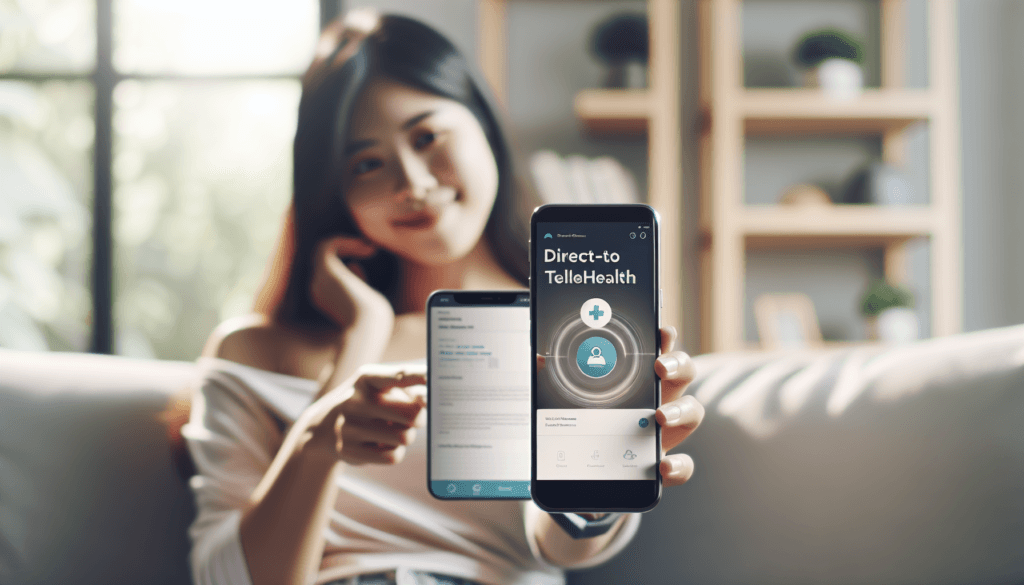Direct-to-Consumer Telehealth services have become increasingly popular in recent years, revolutionizing the way individuals access healthcare. These services allow patients to receive medical consultations, diagnosis, and treatment from the comfort of their own homes, eliminating the need for in-person visits to healthcare facilities. In this article, we will discuss the key aspects of direct-to-consumer telehealth services, including their benefits, limitations, and considerations for consumers. Whether you are seeking convenient healthcare options or are simply interested in exploring this emerging trend, understanding the ins and outs of direct-to-consumer telehealth services is essential.

Table of Contents
What is Direct-to-Consumer Telehealth?
Definition
Direct-to-Consumer Telehealth is a form of healthcare delivery that allows patients to access medical services remotely without the need for in-person visits. It involves the use of technology, such as video consultations, phone consultations, and mobile applications, to connect patients with healthcare providers. This approach aims to improve access to healthcare, enhance convenience and flexibility, and reduce healthcare costs.
Advantages
Direct-to-Consumer Telehealth offers several advantages to patients. Firstly, it improves access to healthcare, especially for those living in remote or underserved areas. Patients no longer need to travel long distances to visit a doctor, as they can receive medical consultations from the comfort of their own homes. Additionally, telehealth services provide increased flexibility by allowing patients to schedule appointments at their convenience, including outside of regular office hours. This flexibility is particularly beneficial for individuals with busy schedules or limited mobility.
Another advantage is the potential cost-effectiveness of telehealth services. By eliminating the need for travel and reducing administrative overhead, telehealth can offer cost savings for both patients and healthcare providers. This can have a positive impact on healthcare affordability, especially for those without comprehensive insurance coverage.
Disadvantages
Despite its numerous advantages, Direct-to-Consumer Telehealth also has some disadvantages. One of the main concerns is insurance coverage. While telehealth services are generally covered by insurance, the extent of coverage can vary. Patients need to ensure that their insurance plans include telehealth benefits and understand any limitations or additional costs associated with such services.
Another important consideration is the legality and regulation surrounding telehealth practices. Each state and country may have different laws and regulations regarding telehealth, and healthcare providers need to comply with these regulations to ensure patient safety and quality of care. Privacy and security are also critical concerns, as the transmission and storage of medical information through telehealth platforms must adhere to strict privacy standards to protect patient confidentiality.
Types of Direct-to-Consumer Telehealth Services
Video Consultations
Video consultations involve real-time communication between patients and healthcare providers through video platforms. This method allows for a more personal and interactive experience, as patients can visually communicate their symptoms, and doctors can observe physical cues. Video consultations are well-suited for a wide range of medical issues, including assessing minor injuries, managing chronic conditions remotely, and offering psychiatric consultations.
Phone Consultations
Phone consultations are a convenient option for individuals who prefer verbal communication or do not have access to stable internet connections. Patients can discuss their medical concerns with healthcare providers over the phone, and doctors can provide medical advice and treatment recommendations. Phone consultations are suitable for non-urgent medical issues, such as medication refills, follow-up appointments, or simple medical inquiries.
Mobile Application Services
Mobile application services are gaining popularity in the realm of telehealth. These applications enable patients to access a variety of healthcare services, including virtual consultations, appointment scheduling, prescription renewals, and health monitoring. Mobile applications offer convenience and accessibility, allowing patients to receive medical care whenever and wherever they need it. However, it’s important to ensure that the applications are reputable, secure, and user-friendly.
Benefits of Direct-to-Consumer Telehealth Services
Improved Access to Healthcare
Direct-to-Consumer Telehealth significantly improves access to healthcare, particularly for individuals living in rural or remote areas. It eliminates geographical barriers and allows patients to connect with healthcare providers, including specialists, regardless of their physical location. This expanded access enables timely medical interventions, early detection of conditions, and appropriate management of chronic diseases.
Convenience and Flexibility
One of the key benefits of Direct-to-Consumer Telehealth is the convenience and flexibility it offers. Patients no longer need to travel long distances, take time off work, or wait in crowded waiting rooms for their appointments. Telehealth services allow individuals to schedule consultations at their preferred time, even outside of normal office hours. This flexibility is especially valuable for individuals with busy schedules, limited mobility, or those residing in areas with limited healthcare resources.
Cost-Effectiveness
Direct-to-Consumer Telehealth can be a cost-effective option for both patients and healthcare providers. It eliminates the need for travel expenses, parking fees, and other associated costs often incurred during in-person visits. By reducing administrative overhead and streamlining processes, telehealth services can also lead to cost savings for healthcare providers, which can ultimately translate to lower healthcare costs for patients. Additionally, telehealth can reduce the burden on emergency departments by providing timely and accessible care for non-emergency conditions, ultimately reducing healthcare costs for the entire system.
Considerations Before Using Direct-to-Consumer Telehealth Services
Insurance Coverage
Before utilizing Direct-to-Consumer Telehealth services, it is essential to confirm the coverage provided by your insurance plan. Not all plans may fully cover telehealth consultations, or there may be limitations on the types of conditions eligible for telehealth services. Contact your insurance provider to understand the extent of coverage, any associated copayments or deductibles, and the process for reimbursement or payment.
Legality and Regulation
Each jurisdiction has its own set of laws and regulations governing telehealth practices. It is crucial to verify the legality of receiving telehealth services in your particular area and ensure that the healthcare provider you choose complies with the relevant regulations. This includes verifying the licensing and credentials of the healthcare professionals offering telehealth services to ensure the delivery of safe and effective care.
Privacy and Security
When utilizing Direct-to-Consumer Telehealth services, it is important to prioritize privacy and security. Ensure that the telehealth platform being used employs robust security measures to protect your personal and medical information. Look for platforms that are compliant with relevant privacy regulations, such as the Health Insurance Portability and Accountability Act (HIPAA) in the United States. Additionally, be cautious when sharing sensitive information, and only use reputable and trusted telehealth providers.

How Direct-to-Consumer Telehealth Services Work
Registration and Account Setup
To begin using Direct-to-Consumer Telehealth services, patients typically need to create an account and register with the telehealth provider. This process may involve providing personal information, such as name, contact details, and insurance information. Some telehealth platforms may require additional documentation, such as identification verification or completion of medical history forms.
Scheduling Appointments
Once registered, patients can schedule appointments through the telehealth platform. Many platforms offer online scheduling tools that allow patients to select a preferred date and time for their consultation. The availability of healthcare providers may vary, but most telehealth services strive to offer flexible appointment options to accommodate patients’ needs.
Consultation Process
During the consultation, patients connect with a healthcare provider via video, phone, or mobile application. The healthcare provider will discuss the patient’s medical concerns, ask relevant questions, and may request additional information or images. Based on the consultation, the provider will provide a diagnosis, treatment recommendations, and prescriptions if necessary. Telehealth platforms often facilitate secure electronic transmission of prescriptions to the patient’s preferred pharmacy.
Conditions Treated by Direct-to-Consumer Telehealth Services
Minor Illnesses and Injuries
Direct-to-Consumer Telehealth services are well-suited for the diagnosis and treatment of minor illnesses and injuries. Common conditions that can be effectively managed through telehealth include cold and flu symptoms, minor infections, allergies, rashes, and minor injuries, such as sprains or strains. Telehealth providers can assess symptoms, provide medical advice, and prescribe appropriate medications to alleviate symptoms or manage the condition until an in-person visit is necessary.
Chronic Disease Management
Direct-to-Consumer Telehealth is increasingly being utilized in the management of chronic diseases. Patients with conditions such as diabetes, hypertension, asthma, or chronic obstructive pulmonary disease (COPD) can benefit from regular virtual consultations. Telehealth allows healthcare providers to monitor symptoms, review treatment plans, adjust medications, and provide ongoing support and education to patients. By regularly monitoring and managing chronic conditions remotely, telehealth services can help improve patient outcomes and reduce the need for frequent in-person visits.
Mental Health
Telehealth services play a crucial role in providing access to mental health support. Individuals experiencing depression, anxiety, stress, or other mental health conditions can receive counseling and therapy through telehealth platforms. Mental health professionals can conduct virtual sessions and provide evidence-based interventions, such as cognitive-behavioral therapy or medication management. Telehealth for mental health offers the benefits of privacy, convenience, and reduced stigma, making it an accessible and effective treatment option for many individuals.

Limitations of Direct-to-Consumer Telehealth Services
Limited Physical Examination
One of the main limitations of Direct-to-Consumer Telehealth services is the inability to conduct a comprehensive physical examination. Healthcare providers rely on visual observation and patient-reported symptoms to make diagnoses and treatment decisions. While this is sufficient for many conditions, there may be instances where a physical examination or diagnostic tests are necessary for accurate diagnosis. In such cases, the telehealth provider may refer the patient for an in-person visit or further testing.
Lack of Continuity of Care
Direct-to-Consumer Telehealth services may lack the continuity of care that traditional in-person healthcare provides. In a telehealth setting, patients may interact with different healthcare providers for each consultation, leading to reduced familiarity and continuity in their care. While telehealth platforms strive to maintain comprehensive medical records and communication between providers, some patients may prefer the consistency and trust that comes with seeing the same healthcare provider for all their medical needs.
Emergency Situations
Direct-to-Consumer Telehealth services are not suitable for emergency situations or life-threatening conditions that require immediate medical attention. In emergencies, patients should always seek immediate care through emergency services or visit the closest emergency room. Telehealth services are designed for non-emergency conditions and as a supplement to routine care rather than a replacement for emergency medical services.
Choosing a Direct-to-Consumer Telehealth Service
Research and Reviews
When choosing a Direct-to-Consumer Telehealth service, it is beneficial to conduct research and read reviews from other users. Look for telehealth platforms with positive feedback, high user ratings, and a good reputation for providing quality care. Platforms with a large network of healthcare providers and various specialties can offer more choices and ensure access to the appropriate expertise for your specific medical needs.
Licensing and Accreditation
Ensure that the telehealth service you choose operates within the legal framework of your jurisdiction and that the healthcare providers are appropriately licensed and accredited. This helps ensure that you are receiving care from qualified professionals who adhere to professional standards and ethics.
User-Friendly Interface
Consider the user-friendliness and accessibility of the telehealth platform. Look for platforms that offer intuitive interfaces, easy scheduling tools, and secure methods for transmitting medical information. A user-friendly platform enhances the overall telehealth experience and makes it easier for patients to access the care they need.

Common Concerns and Misconceptions about Direct-to-Consumer Telehealth Services
Quality of Care
Some individuals may have concerns about the quality of care provided through telehealth. However, studies have shown that telehealth can deliver care comparable to that provided in traditional in-person settings. Telehealth platforms strive to ensure that healthcare providers are qualified and licensed professionals who deliver evidence-based care. Regular monitoring, quality assurance, and patient feedback mechanisms further support the delivery of high-quality care.
Medical Erroneous Assumptions
Another misconception is that telehealth services may lead to medical errors due to the lack of physical examination. While telehealth consultations rely on patient-reported symptoms and visual observation, healthcare providers undergo thorough training to make accurate diagnoses and treatment recommendations based on the available information. Providers may ask detailed questions, request images, or suggest follow-up visits when necessary to mitigate the risk of errors.
Replacing Primary Care
Direct-to-Consumer Telehealth services are not intended to replace primary care or comprehensive in-person medical visits. They are designed to complement traditional healthcare and provide convenient and accessible care for non-emergency conditions. Collaborative care models that integrate telehealth with primary care can enhance patient outcomes, improve continuity of care, and facilitate seamless transitions between virtual and in-person visits when required.
The Future of Direct-to-Consumer Telehealth Services
Technological Advancements
The future of Direct-to-Consumer Telehealth services is closely tied to technological advancements that will enhance the virtual healthcare experience. Advancements in wearable devices, remote monitoring technologies, and artificial intelligence have the potential to further expand the capabilities of telehealth. Remote patient monitoring can enable real-time data collection and proactive interventions for chronic disease management, while AI-powered algorithms can assist healthcare providers in making accurate diagnoses remotely.
Regulatory Changes
As the demand for telehealth continues to grow, regulatory changes are likely to occur to accommodate the evolving healthcare landscape. Governments and regulatory bodies will need to adapt policies and regulations to ensure patient safety, privacy, and quality of care. The expansion of insurance coverage for telehealth services and the standardization of reimbursement rates will also contribute to the growth and sustainability of Direct-to-Consumer Telehealth.
Integration with Primary Healthcare
The integration of Direct-to-Consumer Telehealth services with traditional primary healthcare is a key trend in the future of healthcare delivery. This integration will involve seamless coordination between virtual consultations and in-person visits, allowing patients to receive comprehensive care while leveraging the convenience and accessibility of telehealth. Collaborative care models that bring together primary care physicians, specialists, and telehealth providers will ensure continuity and coordination of care across different modalities.
In conclusion, Direct-to-Consumer Telehealth services offer valuable benefits, including improved access to healthcare, convenience, and cost-effectiveness. While there are considerations and limitations to be aware of, telehealth continues to evolve and is poised to play an increasingly significant role in the future of healthcare delivery. With ongoing advancements in technology, regulatory support, and integration with primary care, Direct-to-Consumer Telehealth is likely to become an integral part of the healthcare landscape, providing accessible and quality care to patients worldwide.

Related site – An academic’s perspective on DTC telehealth services: Buyer beware

